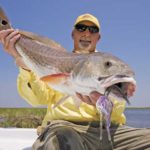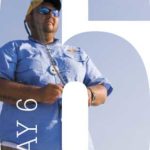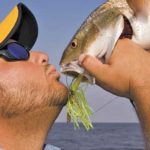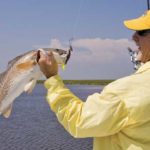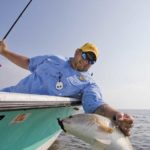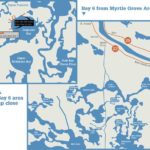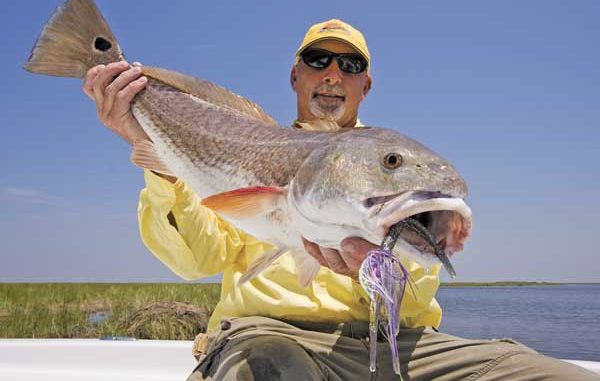
Fishing this Lafitte redfish hotspot is not much different than blasting fish in a barrel.
After searching high and low for a redfish around Lafitte, Capt. Frank Lawson instructed me to pull it in. Before I could even get my rod settled into its holder, he jammed the throttle forward, and his Champion bay boat lurched forward.
We had made several moves so far that day, but this one was different. Whereas the other moves had come to an end in just a few minutes, this one kept going … and going … and going.
Forty minutes later, Lawson, who guides for Bourgeois Charters, finally eased off the gas as he made a sweeping turn into a wide-open bay. As we coasted toward the far bank, Lawson told me that this was a place called Bay Six.
I had heard of Bay Five before; it’s prominently labeled on most any map of the Barataria system, but Bay Six? Never even heard of it.
I had to keep in mind that Lawson was the guide and that I was just the tag-along, so I put my redfish faith in Capt. Frank.
“Man, look at that far bank,” he said as the boat eased through the middle of the bay. “That’s what this place can do for you. We’ve been struggling all day just to find a fish, and look at this — it’s loaded with bull reds.”
I was happy to hear that we were about to be catching some bull reds because I had a new Berkley Cobalt Fire rod that I wanted to put through its paces, and there isn’t a better rod-tester out there than a big old bull red. Bay Five, Six, Seven or Eight — I didn’t care where we were. I just wanted to catch a fish.
“We caught a bunch of big reds in here about a month ago,” Lawson said. “They were here for a little while, then they left. That’s the kind of place Bay Six is. They’re either in here, and you’ll work on them, or they aren’t and you won’t. Either way, you’ll know soon enough whether you should stay and fish or try another spot.”
I wondered aloud how Lawson could know so quickly if the reds were present. He pointed out all the monstrous wakes that looked like small submarines moving about on the bank as we got closer.
“That’s how,” he said as we moved into casting range. “The water on this bank is so shallow that if the reds are here, you’ll see them pushing all over the place. If you don’t see all these wakes, I would say to make a few blind casts just to make sure, but you’ll probably need to try another area around here like Bay Round or Bay Five.”
Bay Six, which is labeled on Google Earth and most other maps at Raquette Bay, is positioned just to the south of Lake Laurier, to the east of Lake Five and to the north of Upper Wilkinson Bay. The entire area is a haven for redfish, and those that find their way into Bay Six typically favor one particular side — the side we were just about to fish.
Capt. Damon Williams, another Bourgeois Charters guide, would later explain that the best spot in Bay Six is the northwest corner where a few drains empty into the lake. In fact, Lawson and Williams almost exclusively fish this one particular section every time they fish Bay Six.
“You can pick up a few fish here and there in Bay Six, but the northwest side is by far the best section,” said Williams. “I guess those big reds like to get on that bank with the drains so they can sit there and wait on all that bait to wash out into the open water.
“And even if they aren’t in the drains, they’ll scatter out up and down that particular shoreline because the bait will eventually spread out along that bank.”
As Lawson and I began casting BOOYAH Samurai Blade spinnerbaits rigged with black/chartreuse YUM Samurai Shad soft plastics, we quickly noted that the reds seemed to be very unconcerned with our offerings. We would see a wake, make a cast and get just the slightest bump — if any bump at all.
“This is weird,” Lawson said as he missed another bump. “I don’t know if it’s the time of day (it was the middle of the afternoon) or what, but you usually don’t have to worry about whether these pushing fish are going to bite. It’s usually a given.”
After trying black/chartreuse cocahoe minnows on jigheads, gold spoons and even the BOOYAH Boogee Bait, a chatter-style bait that works like a spinnerbait, jig and crankbait all rolled into one, we were at a loss for words and an even bigger loss for fish. My Cobalt Fire rod remained just as straight as it had been standing in Lawson’s rod holder.
“Maybe we’ve got to get closer to the drains,” Lawson said as he kicked his trolling motor up on high. “I always start a little south of the drains just to see if the fish are spread out down the bank. Maybe it’ll get better the closer we get to those cuts.”
I continued throwing my spinnerbait as he zoomed toward the cuts, and we quickly found out what it was throwing all those wakes. My maiden fish on my new rod was a beautiful black drum. I got to feel the rod bend a little bit, but for this trip, the fish was the wrong color.
As we moved closer to the cuts, Lawson noticed that the wakes were getting decidedly more pronounced. They were wider and deeper. They had the look of bull reds swimming just under the surface.
Our spinnerbaits, spoons, soft plastics and chatter baits were ignored no longer. It seemed like every cast was rewarded with a hard-pulling redfish.
In the super-shallow water in the northwestern corner of Bay Six, the fights looked and sounded as violent as they felt.
“Just like clockwork,” Lawson said as he released another redfish back into Bay Six.
We had already reached our limit of bull reds, which isn’t nearly as impressive as it sounds. Both of us had already fought and landed one fish over 27 inches. The rest was just lagniappe as we put our tackle, or gear and our hearts to the test.
When our arms and legs just couldn’t take anymore, we decided to make our way back to Lafitte and swap stories with the other guides and anglers that we were sure were already back licking crawfish juice off their fingers. As we idled back out of Bay Six, Lawson explained a little more about the allure this seemingly innocent-looking bay has over the redfish.
“I don’t know if the fish come in here to spawn or what,” he said. “I would imagine that’s what they do. Whatever it is, they funnel in and out of here all summer long. It’s definitely a summer hole, because by the end of September, they’ll start making their way up to Lake Salvador or who knows where else.
“After September, I may check in here every now and then, but I really don’t start hitting it hard again until the next May or July.”
Beyond being where the cuts come into Bay Six, Lawson theorized that the reds favor the northwest shoreline because it tapers off gradually, much like a beach would along the coastline. The rest of the shore around Bay 6 tends to drop straight off. And in here, the reds favor the sloping shore more than the deeper banks.
Pointing out some of the pockets back in the surrounding marsh as we exited Bay Six, Lawson explained that the bull reds rarely get back in them. While the ponds will get thick with grilling-sized reds, the fish over 27 inches seem to prefer the main bay.
“I’m not saying that some of the big reds don’t push back in them when the tide comes up,” Lawson said, “but I’ve caught just as many reds on the same northwestern bank during high tide as I have during low tide. And I don’t even think the tide matters too much in here. I’ve caught them all day long regardless of what the tide was doing, so I would say it’s an all-day bite if they’re in here.”
Williams would later explain that he believed the matter of the reds being in Bay Six has everything to do with whether the bait is in the bay or not. He says as long as the water is clean and the bait is there, the reds should be there, too.
“I just go in there and check every two weeks or so during the summer,” said Williams. “Of course, if I find them in there, I’ll keep going back and working on them until they move out. The way I check is to fish that same corner with the drains. If they’re in there, that’s where they’ll be.”
One thing that Williams has noticed about the Bay Six redfish is that they don’t gang up like they do in places like Lake Salvador. Rather than seeing big schools of five, 10 or even 15 fish, he says you’re more likely to see isolated fish that are more spread out.
“They don’t seem to get out in the middle of Bay Six like they do in some of the surrounding lakes,” he said. “In Bay Six, it’s all about that one particular shallow shoreline.”
According to Lawson and Williams, the two best times to fish Bay Six during the summer months are early in the morning and late in the evening. Redfish like to move toward the surface during both periods, and that’s when they’re most frequently seen actively feeding in the shallow water.
“I love the morning,” said Williams. “Get out there and fish the first 45 minutes of the morning with the black MirrOlure She Dog with the chartreuse nose. When those big bulls crush that thing, it’s a sight to see. While I favor the black/chartreuse, I imagine they are more attracted to the noise than they are anything else.”
After putting down the topwater, Lawson and Williams fish what they believe is the most productive lure for Bay Six — a black/chartreuse Cocahoe tightlined on a jighead. Rather than bump the bottom, they both fish it with a steady pull about 6 to 8 inches below the surface.
“You may want to let it bump down every now and then,” said Lawson, “but that straight pull seems to be the best way to fish it. If the plastic doesn’t work, tie on a gold spoon and do the same thing by fishing it on a straight pull just below the surface.”
Neither angler leaves Bay Six without first chunking and winding a spinnerbait. Williams takes the plastic off of a Strike King Redfish Magic spinnerbait, and threads on the same black/chartreuse Cocahoe that he fishes on the jighead.
“This is when it gets just like bass fishing,” said Williams. “Even if you don’t see the fish moving around, I would recommend making a few blind casts with the spinner. Try cranking it about 10 to 20 feet, then give it a little shake. Crank it another 10 to 20 feet, and pop it again. That little fluttering action it gets when you pop it seems to attract any fish that just happens to see it.”
And don’t forget about the chatter-style baits. When everything else seems to fail, these pulsating blade baits put out so much vibration that Williams has seen fish come from several feet away to crush them.
“Either they are attracted to the vibration and they’re just curious to see what’s making it, or they want to shut that thing up,” he said. “That’s a crazy-looking bait in the water, and the reds go nuts over it.”
If you want to go a little nuts yourself, give Bay Six a try this month before it’s too late. Just look for Raquette Bay on your map, and check it out the next time you’re on the water.
It may not be just like shooting fish in a barrel, but it’s probably as close as you’re ever going to get.
